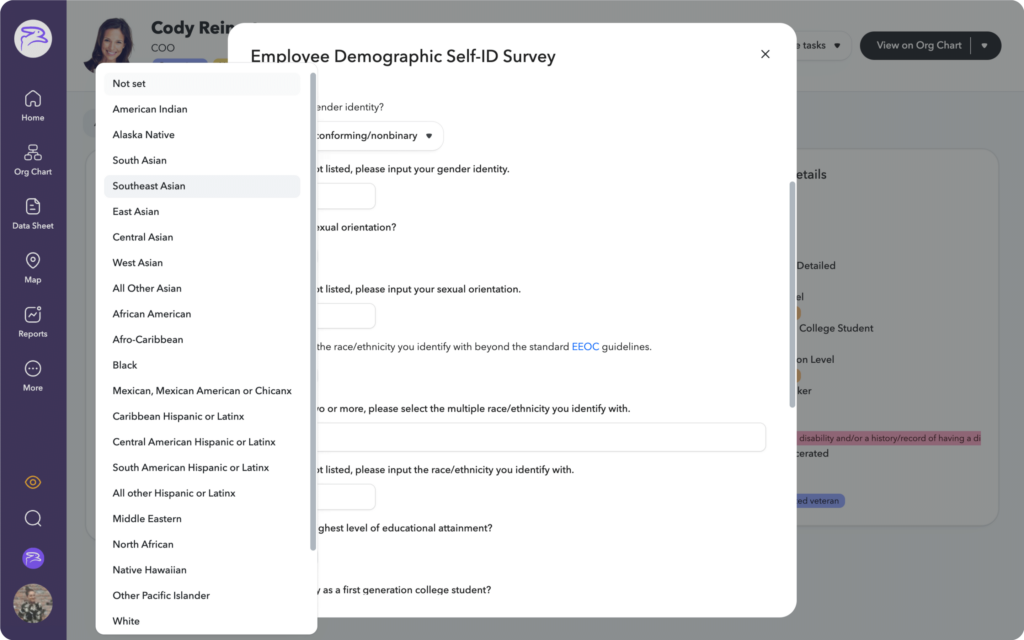If you’re serious about creating a people-first culture, then diversity, equity, inclusion, and belonging (DEIB) should be at the top of your priority list. We know there’s many ways to increase DEIB efforts, such as establishing a dedicated DEIB team and looking at people data through a DEIB lens.
However, you can search for all of the DEIB best practices in the world and still not understand what your people want. Luckily, how you determine what your employees need is simple: you ask them.
Their answers to questions on diversity and inclusion will help you drive insights and plan efforts intentionally and strategically. That way, you can spend time making changes that your people want to see to create a healthier workplace environment.
Not sure where to start? Read our questions below to start building your DEIB survey today.
Want to learn more about the difference between DEI vs. DEIB?
Read our guide here
Include These Questions in Your DEIB Survey
Below are 25 questions to include in your DEIB survey. Note that the below questions on diversity and inclusion are divided into categories, which will provide more clarity for employees. And while the first 17 questions use a five-point scale as answers, the last eight are short answers, which allows employees to provide further explanation if they wish.
Opening Questions
These questions summarize employees’ overarching feelings about your organization’s DEIB efforts.
- Our workforce mimics the diversity of the world.
- Leadership (executives and managers) are representative of all communities.
- We’re making strong efforts to recruit, hire, and retain underrepresented talent.
- Our approach to DEIB is reflected in the product and service offerings we bring to market.
Protection From Harm Questions
These questions focus on physical safety, psychological safety, and safe spaces.
- I feel physically and psychologically safe in our workplace. (e.g. You feel comfortable sharing feedback/receiving feedback from others.)
- There are opportunities for rest within our work schedule and workplace.
- The executive team prioritizes DEIB policies and initiatives.
- Team members recognize DEIB as an organizational priority.
Work-Life Harmony Questions
These questions focus on the balance of work and life.
- Our organization ensures that there is limited work outside of work hours.
- Leaders (executives, managers, etc) in our workplace model healthy behaviors and boundaries.
- I have autonomy in my work and how my work is done.
Mattering at Work Questions
These questions focus on feeling included and valued.
- We are given the opportunity to meaningfully recognize and show appreciation for our team members.
- I understand our company’s mission and how my work contributes to achieving it.
- Our organization has created a culture of appreciation, with opportunities to grow and be recognized.
- I feel that I have a clear path for growth professionally and personally within this organization.
Connection and Community Questions
These questions focus on connecting with others.
- I feel included, that my voice is heard and that I belong within our organization.
- I am able to connect with my peers on a social level outside of standard, scheduled meetings.
- Are you a member of an ERG, and if so, which one(s)?
- If you are not a member of an ERG, why haven’t you joined?
Change Management and Future of DEIB Questions
These questions focus on feelings about change within the organization and the future of DEIB. Note that these questions are open-ended questions for people to explain their thoughts and reasoning.
- Given the pace of change, how can leadership better support teams?
- What do you think of the role of DEIB within our organization?
- What would you like to see from DEIB next year?
- What would you like to see less of from DEIB next year?
Bonus Questions
- Open Forum Questions: Allow employees to explain their answers further by offering an Open Forum space at the end of each section. That way, they can provide more context to their answers if they so choose.
- Identifiers: It’s always a good idea to collect information anonymously (as it encourages respondents to be honest while answering). However, you can include voluntary questions – such as department, gender, age, ethnicity, and level in the company – to help spot trends in your answers. It’s also a preferred practice to send out an additional Self-ID survey to help ensure you’re respecting employees’ backgrounds and planning initiatives with everyone in mind.

Consider sending out a separate, voluntary Self-ID survey to improve your DEIB efforts and continue making people-first decisions.
Act on Your Survey Results
Creating and distributing your survey is an important component of your DEIB strategy. That’s why the above themes are so critical to assess: they encompass various parts of your employee experience, help ensure your people feel supported every day, and pinpoint what’s important to your people.
But your intentionality can’t stop there. In fact, the real work happens after results are collected: when you build, communicate, and enact a plan to identify and address DEIB concerns. Ultimately, how you roll out and implement your DEIB efforts will help establish trust and buy-in, putting you one step closer to creating a more equitable work environment.
Ready to go beyond asking questions about diversity and inclusion? The next step is using your DEIB data to make informed decisions.
Learn how here

Felecia Phillips Ollie DD (h.c.) is the inspiring leader and founder of The Equality Network LLC (TEN). With a background in coaching, travel, and a career in news, Felecia brings a unique perspective to promoting diversity and inclusion. Holding a Bachelor’s Degree in English/Communications, she is passionate about creating a more inclusive future. From graduating from Mississippi Valley State University to leading initiatives like the Washington State Department of Ecology’s Equal Employment Opportunity Program, Felecia is dedicated to making a positive impact. Join her journey on our blog as she shares insights and leads the charge for equity through The Equality Network.




